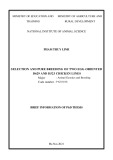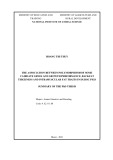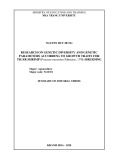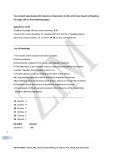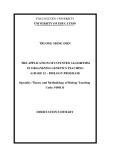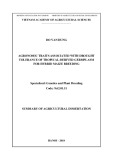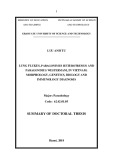Eur. J. Biochem. 268, 6221–6228 (2001) q FEBS 2001
Inhibition of glycosyl-phosphatidylinositol biosynthesis in Plasmodium falciparum by C-2 substituted mannose analogues
Cristiana Santos de Macedo, Peter Gerold, Nicole Jung, Nahid Azzouz, Ju¨ rgen Kimmel and Ralph T. Schwarz
Med. Zentrum fu¨r Hygiene und Medizinische Mikrobiologie, Philipps-Universita¨t Marburg, Marburg, Germany
that no actual
respectively),
glycolipids was observed only in the presence of tritiated or nonradiolabelled 2-deoxy-D-glucose. Mannosamine inhibits GPtdIns biosynthesis at a concentration of 5 mM, but neither an accumulation of aberrant intermediates nor significant inhibition of total protein biosynthesis was observed in the presence of this analogue. Furthermore, the [3H]manno- samine-labelled glycolipid spectrum resembled the one described for [3H]glucosamine labelling. Total hydrolysis of mannosamine labelled glycolipids showed that half of the tritiated mannosamine incorporated into glycolipids was converted to glucosamine. This high rate of conversion led us to suggest inhibition from GPtdIns biosynthesis is achieved with the treatment with manno- samine, which is different to what has been observed for mammalian cells and other parasitic protozoa.
Keywords: glycosylphosphatidylinositol; Plasmodium falciparum; D-mannosamine; 2-deoxy-D-glucose; 2-deoxy- 2-fluoro-D-glucose.
Mannose analogues (2-deoxy-D-glucose, 2-deoxy-2-fluoro- D-glucose and 2-amino-2-deoxy-D-mannose) have been used to study glycosylphosphatidylinositol (GPtdIns) biosynthesis and GPtdIns protein anchoring in protozoal and mammalian systems. The effects of these analogues on GPtdIns biosynthesis and GPtdIns-protein anchoring of the human malaria parasite Plasmodium falciparum were evaluated in this study. At lower concentrations of 2-deoxy-D-glucose and 2-deoxy-2-fluoro-D glucose (0.2 and 0.1 mM, respectively), GPtdIns biosynthesis is inhibited without significant effects on total protein biosynthesis. At higher concentrations of 2-deoxy-D-glucose and 2-deoxy- 2-fluoro-D-glucose (1.5 and 0.8 mM, the [3H]glucosamine into glycolipids was incorporation of inhibited by 90%, and the attachment of GPtdIns anchor to merozoite surface protein-1 (MSP-1) was prevented. However, at these concentrations, both sugar analogues inhibit MSP-1 synthesis and total protein biosynthesis. In to 2-deoxy-2-fluoro-D-glucose and 2-amino- contrast 2-deoxy-D-mannose (mannosamine), the formation of new
Glycosylphosphatidylinositols (GPtdIns) represent a class of glycolipids responsible for the anchoring of proteins on the outer leaflet of the plasma membrane (reviewed in [1–6]). GPtdIns from parasitic protozoa have been related to the pathology of many parasitic diseases [5]. The human malaria parasite, Plasmodium falciparum, has been shown to synthesize a spectrum of GPtdIns molecules [7], which represent a class of malarial toxins [6]. These toxins are involved in activation of host cell macrophages, induction of NO release and up-regulation of endothelial cell markers [8–10]. Major surface proteins of P. falciparum merozoites
[for example, merozoite surface protein (MSP)-1 and -2] are GPtdIns-anchored [11]. Biosynthesis of GPtdIns in Plas- modium has been established by characterizing the structures of putative biosynthesis intermediates synthesized by parasite cultures [7,12]. More detailed understanding of the biosynthesis pathway and function of GPtdIns came from the use of specific inhibitors of the GPtdIns biosynthesis. A recently established fungi metabolite (YW3548) was shown to inhibit GPtdIns-biosynthesis in yeast and mammalian cells but not in parasitic protozoa [13]. Structural analogues of GPtdIns having modified hydroxylgroups at the inositol were shown to inhibit selectively GPtdIns-biosynthesis in cell-free systems pre- pared from Trypanosoma brucei and Leishmania mexicana but not from HeLa cells [14,15]. Therefore, C-2 substituted mannose analogues are the only inhibitors known to affect GPtdIns-synthesis and GPtdIns-anchoring of surface molecules in mammalian cells and protozoa (reviewed in [16]). 2-Amino-2-deoxy-D-mannose (mannosamine) has been used to study GPtdIns biosynthesis in a variety of cell-types and organisms. In all systems investigated so far, mannosamine was able to inhibit GPtdIns biosynthesis. In T. brucei, mannosamine inhibits the incorporation of ethanolamine into GPtdIns protein by being incorporated into GPtdIns-biosynthesis intermediates [17]. This leads to the accumulation of a ManN-Man-GlcN-PtdIns inter- mediate, which could not be mannosylated at the C-2 position [18]. In mammalian cells there are discrepant data
Correspondence to R. T. Schwarz, Med. Zentrum fu¨r Hygiene und Medizinische Mikrobiologie, Philipps-Universita¨t Marburg, Robert-Koch-Strasse 17, 35037 Marburg, Germany. Fax: 1 49 6421 2868 976, Tel.: 1 49 6421 2865149, E-mail: schwarz@mailer.uni-marburg.de Abbreviations: GPtdIns, glycosylphosphatidylinositol; PtdIns, phosphatidylinositol; Man, mannose; ManN, mannosamine; GlcN, glucosamine; EtN, ethanolamine, 2dGlc, 2-deoxy-D-glucose, Dol- P-Man, dolichol-phosphate-mannose; HPAEC, high pH anion exchange chromatography; GPtdIns-PLC, glycosylphosphatidylinositol- phospholipase C; GPtdIns-PLD, glycosylphosphatidylinositol- phospholipase D; MSP-1, merozoite surface protein-1; MDCK, Madin–Darby canine kidney; TLC, thin-layer chromatography. (Received 22 June 2001, revised 26 September 2001, accepted 3 October 2001)
6222 C. Santos de Macedo et al. (Eur. J. Biochem. 268)
q FEBS 2001
Parasites
P. falciparum strain FCBR was obtained from B. Enders, Behring Co. (Marburg, Germany). It was maintained as previously described [32]. Development and multiplication of plasmodial cultures was followed by microscopic evaluation of Giemsa-stained smears. Parasite cultures were routinely checked for Mycoplasma contamination. Inhibition of parasite multiplication was assessed as described [29].
Metabolic labelling of parasites
on the incorporation of mannosamine into GPtdIns precursors [19,20]. Using Madin –Darby canine kidney (MDCK) cells, mannosamine was shown to be incorporated into GPtdIns biosynthesis intermediates [19] whereas no incorporation of mannosamine into GPtdIns was observed using HeLa or lymphoma cells [20], despite of the inhibition of GPtdIns biosynthesis with the accumulation of Man2-GPtdIns. These data suggested a direct inhibition of the enzyme a1,2-mannosyltransferase by mannosamine. Nonetheless, mannosamine inhibits the labelling of GPtdIns-anchored proteins by tritiated ethanolamine and mannose, and the polarized distribution of GPtdIns- anchored proteins in polarized epithelial cells [17]. In L. mexicana, synthesis of glycosylated inositol phospholi- pids was inhibited by incorporation of mannosamine, whereas the formation of lipophosphoglycans was inhibited without mannosamine incorporation [21].
To test for the effects of mannose analogues on the incorporation of radioactive precursors, parasite cultures were preincubated with inhibitors for 2 h prior to the start of labelling. Metabolic labelling of parasite cultures using tritiated glucosamine, mannose, mannosamine, 2-deoxy- D-glucose or [35S]methionine was performed as described previously [7,11]. Incubations were performed for 3 h (glycolipids) or 8 h (glycoproteins) at 37 8C.
Viability of parasites
Mannose analogues such as 2-deoxy-2-fluoro-D-glucose and 2-deoxy-D-glucose have been shown to inhibit GPtdIns biosynthesis (reviewed in [16,22,23]), as both of them inhibit the formation of dolichol-phosphate-mannose [24,25], the donor for the mannose residues in GPtdIns biosynthesis [26]. Incubation of mammalian cells with 2-deoxy-2-fluoro-D-glucose led to an inhibition of GPtdIns- anchoring of alkaline phosphatase and accumulation of a precursor protein having an uncleaved GPtdIns-attachment peptide [27]. 2-Deoxy-D-glucose has not been described to inhibit GPtdIns biosynthesis until now.
After 10 h of incubation, the viability of parasites was assessed by light microscopy of Giemsa-stained smears and measured by [35S]methionine incorporation into total proteins by liquid scintillation counting, after trichloroacetic acid precipitation of proteins on filter membranes [29].
Extraction and purification of lipids
Inhibition of malaria parasite P. falciparum multipli- cation in culture has been described for mannose analogues [28–31]. However, it remains unclear if these effects were due to an inhibition of GPtdIns synthesis and/or protein biosynthesis, the inhibition of glucosamine uptake or other effects of mannose analogues on the parasite. It is known that light microscopy is a very sensitive method to obtain information about the viability of malaria parasites, and is used routinely to check multiplication and development of P. falciparum cultures.
For a more detailed understanding and to establish mannose analogues as potential specific inhibitors of the biosynthesis of GPtdIns, we tested the in vivo effects of the C-2 substituted mannose analogues mannosamine, 2-deoxy- 2-fluoro-D-glucose and 2-deoxy-D-glucose on the biosyn- thesis of free and protein-bound GPtdIns in Plasmodium falciparum in comparison to total protein biosynthesis.
Glycolipids were extracted with chloroform/methanol/water (10 : 10 : 3, v/v/v) as described [32]. The chloroform/ methanol/water-extracted glycolipids were dried in a Speed- vac concentrator (Savant Inc.), subjected to repeated ‘Folch’ washings, and finally, partitioned between water and water- saturated n-butanol. Washed glycolipid extracts were analysed on silica gel 60 TLC plates using chloroform/ methanol/water (4 : 4 : 1, v/v/v) as the solvent system. After chromatography, the plates were dried and scanned for radioactivity using a Berthold LB 2842 automatic TLC scanner or analysed by a BAS-1000 Bio-Imaging Analyser (Fuji Film).
M A T E R I A L S A N D M E T H O D S
Total hydrolysis of glycolipid extracts
obtained
from Hartmann
Glycolipid extracts labelled with tritiated glucosamine or mannosamine were hydrolysed with 4 M HCl for 4 h at 100 8C. After treatment samples were washed with methanol, resuspended in water, and filtered through a 0.2-mm filter. Monosaccharides were analysed by high pH anion exchange chromatography (HPAEC) on a Dionex Basic Chromatography System (Dionex Corp.) using a CarboPac PA-1 column (4 mm (cid:2) 250 cm, Bio-LC, Dionex Co., Sunnyvale, CA, USA), and isocratic conditions (10 mM NaOH). Fractions of 0.3 mL were collected and subjected to liquid scintillation. Elution positions of nonradioactive coinjected mannosamine and glucosamine standards were detected using a pulsed amperometric detector.
Materials D-[2-3H]mannose, 2-deoxy-D-[1-3H]glucose, GDP- [2-3H]mannose and [35S]methionine were purchased from Amersham (Germany). D-[6-3H]Glucosamine hydrochlo- (Germany). ride was D-[6 – 3H]Mannosamine was from ARC-Biotrend (Germany). Mannosamine was obtained from Sigma (Germany). 2-Deoxy-D-glucose was from Serva (Germany) and 2-deoxy-2-fluoro-D-glucose was from Calbiochem. All solvents used were of analytical or high-performance liquid chromatography grade and were obtained from Riedel-de- Haen (Germany). Thin-layer chromatography (TLC) plates were from Merck (Germany).
q FEBS 2001
P. falciparum GPtdIns glycosylation inhibition (Eur. J. Biochem. 268) 6223
Analysis of parasite proteins
into total
radioactivity
Incorporation of
parasite Incorporation of proteins was estimated by liquid scintillation counting trichloroacetic acid precipitation of proteins on after filter membranes [29]. radioactivity into the MSP-1 was investigated after immunopurification the protein using the monoclonal antibody 111.4, of specifically raised against MSP-1 (kindly provided by A. A. Holder, Division of Parasitology, National Institute for Medical Research, Mill Hill, London, UK) [11,33].
Preparation of GDP-[3H]Man Standards
Washed parasites (30–40 h post-invasion) were harvested by saponin lysis [7]. Parasite lysates were prepared essentially as previously described [34]. Briefly, about 5 (cid:2) 109 parasites were hypotonically lysed and homogen- ized by 20 strokes of a Dounce homogenizer. An equal volume of double isotonic strength buffer was added. This preparation was designated parasite lysate. All experiments involving parasite lysates were performed with freshly prepared lysates. For cell-free labelling about 5 (cid:2) 108 parasite-equivalents, processed as parasite lysates or membrane preparations, were supplemented with 5 mM MnCl2, 1 mM Coenzyme A (CoA), 1 mM ATP and 2 mCi GDP-[2-3H]mannose. Incubations were performed for 45 – 90 min at 37 8C. Glycolipids were processed as described above.
Fig. 1. TLC analyses of P. falciparum glycolipids synthesized in the presence of mannnose analogues. Parasites were treated in vivo with different concentrations (mM) of 2-deoxy-D-glucose (A), 2-deoxy- 2-fluoro-D-glucose (B) and mannosamine (C), then labelled with tritiated glucosamine and extracted with chloroform/methanol/water (10 : 10 : 3, v/v/v). The chloroform/methanol/water extracts were subjected to repeated ‘Folch’ partitions, dried and partitioned between water and water-saturated n-butanol. Glycolipids recovered in the butanol phase were analysed on silica TLC plates using a chloroform/ methanol/water solvent system (4 : 4 : 1, v/v/v). Plates were then exposed on an imaging plate, which was analysed by a BAS-1000 Bio- Imaging Analyser (Fuji Film Co.). O, origin; F, front. The structure of previously characterized glycolipids are indicated in (A). Uncharacter- ized glycolipids are indicated with (*). E, ethanolamine; M, mannose; G, glucosamine; aPtdIns, acyl-phosphatidylinositol.
R E S U L T S
Mannose analogues effect GPtdIns biosynthesis in P. falciparum
5 mM, respectively (Table 1). These data suggest an effective inhibition of malarial GPtdIns synthesis using concentrations of the inhibitors that have been described in other systems [16].
sufficient
reduce
to
intermediates, or
The incorporation of tritiated glucosamine into manno- sylated and nonmannosylated GPtdIns was inhibited using the three mannose analogues (Fig. 1A–C). The presence of 2-deoxy-D-glucose led to the formation of new glycolipids, despite the presence of 2-deoxy-2-fluoro-D-glucose or in the presence of 2-deoxy- mannosamine. However, 2-fluoro-D-glucose, it was observed that the formation of late mannosylated intermediates (Man4-GlcN-PtdIns and Man3-GlcN-PtdIns) was specifically blocked. In the case of mannosamine, neither aberrant GPtdIns biosynthetic inter- mediates nor inhibition of the synthesis of any specific intermediate were observed, in contrast to the findings of Naik et al. [31]. We found a dose-dependent inhibition of all species of GPtdIns, and neither mannosylated nor nonmannosylated intermediates accumulated in the pre- sence of mannosamine. The absence of new mannosamine- containing GPtdIns and the inhibition of incorporation of tritiated glucosamine into GPtdIns may point to an inhibition of GPtdIns biosynthesis by a mechanism from the ones observed in other which is different systems, that is, the incorporation of mannosamine into the GPtdIns trimannosyl-core glycan and further accumu- lation of aberrant inhibition of mannosyltransferases.
To test the effects of mannose analogues on the GPtdIns synthesis in Plasmodium, parasite cultures containing late trophozoites (34–42 h post-infection) were pretreated with various concentrations of the mannose analogues manno- samine, 2-deoxy-2-fluoro-D-glucose and 2-deoxy-D-glucose followed by metabolic labelling using tritiated glucosamine in the presence of sugar analogues. Glycolipids were extracted by organic solvents and the radioactivity present was determined by scintillation counting. The stage of the parasites developmental cycle used for these experiments incorporates almost exclusively tritiated glucosamine into GPtdIns [7,32]. Therefore, radioactivity found in glycolipid extracts of glucosamine labelled parasites is indicative of GPtdIns synthesis. The addition increasing amounts of 2-deoxy-D-glucose led to a of decrease in the incorporation of tritiated glucosamine into GPtdIns (Fig. 1A). The presence of 0.2 mM of the 2-deoxy-D-glucose was radioactivity found in GPtdIns by 71% whereas 94% inhibition was achieved by 1.5 mM of 2-deoxy-D-glucose (Table 1). Having present 2-deoxy-2-fluoro-D-glucose or mannosamine gave similar results (Table 1). The incorpor- ation of glucosamine into GPtdIns was inhibited by 61% using about 0.1 mM 2-deoxy-2-fluoro-D-glucose (Fig. 1B and Table 1) or mannosamine (Fig. 1C and Table 1). Complete inhibition (. 90%) of GPtdIns biosynthesis using these two inhibitors was achieved using 0.8 mM and
6224 C. Santos de Macedo et al. (Eur. J. Biochem. 268)
q FEBS 2001
Table 1. Effects of mannose analogues on protein-bound GPtdIns and total protein biosynthesis. P. falciparum proteins and protein-bound anchors were labelled in vivo in the presence of the inhibitors with [35S]methionine and [3H]glucosamine, respectively. Incorporation of radioactivity into proteins and protein-bound anchors were measured by scintillation counting after trichloroacetic acid precipitation of proteins on filter membranes. [35S]Methionine incorporation into total proteins was also used to assess parasite viability.
Inhibitor used mM [3H]GlcN-labelled protein-bound GPtdIns (%) [35S]Methionine-labelled total protein (%)
2-deoxy-D-glucose
0 0.2 1.5 100 28.8 6.0 100 92.7 3.8
2-deoxy-2-fluoro-D-glucose
0 0.1 0.8 100 38.9 11.7 100 102.8 8.1
Mannosamine
Labelling of GPtdIns by tritiated mannose analogues
relative to the incorporation of
0 0.5 5 100 26.7 6.0 100 109.8 95.4
To check for the incorporation of mannose analogues into malarial GPtdIns, parasite cultures were labelled with equivalent amounts of tritiated mannosamine, 2-deoxy- D-glucose or mannose (as a control). Glycolipids were extracted by organic solvents and analysed on TLC (Fig. 2), with GDP-[3H]Man labelled glycolipids as standards. The labelling efficiency differs between the radioactive pre- cursors used. Only 16% (^ 5%) and 34% (^ 7%) of the radioactivity from tritiated 2-deoxy-D-glucose and manno- samine (respectively) was incorporated into malarial glycolipids, tritiated mannose. Because of the lower labelling efficiency of mannosamine and 2-deoxy-D-glucose, minor amounts (about 1/10th of the applied quantity of 2-deoxy-D-glucose and mannosamine) of mannose and glucosamine-labelled glycolipids were used for comparison on the TLC analysis. Labelling with tritiated 2-deoxy-D-glucose showed that this precursor is incorporated into three glycolipids (Fig. 2). These newly formed glycolipids were identified as GPtdIns by their sensitivity towards GPtdIns-specific nitrous acid deamination, GPtdIns-PLC and GPtdIns-PLD (not shown). The spectrum of glycolipids labelled with tritiated mannosamine resembles the one obtained for glucosamine labelled parasites. These glycolipids are GPtdIns as they were sensitive towards GPtdIns-specific nitrous acid deamination, GPtdIns-PLC and GPtdIns-PLD (data not tritiated shown). Besides the mannosylated GPtdIns, mannosamine also labelled the nonmannosylated GPtdIns glucosamine-phosphatidylinositol (GlcN –PtdIns) and glu- cosamine-acylphosphatidylinositol (GlcN-acyl – PtdIns) (Fig. 2). These data imply that mannosamine was incorporated into GPtdIns instead of glucosamine and/or that it was converted to glucosamine prior to incorporation. In order to determine the nature of the labelled sugar present in GPtdIns, total glycolipids of parasites labelled with tritiated mannosamine were subjected to total hydrolysis, and monosaccharide composition was analysed by HPAEC. Radioactive profiles are shown in Fig. 3. It was observed that mannosamine-labelled glycolipids contained approxi- mately half of the incorporated mannosamine converted to
Fig. 2. TLC analyses of P. falciparum glycolipids synthesized in the presence of tritiated mannose analogues. Parasites were labelled in vivo for 3 h with the tritiated precursor indicated, in the presence or absence of mannose analogues. Glycolipids were extracted and processed as described in Fig. 1. The TLC plate was then exposed on an imaging plate, which was analysed by a BAS-1000 Bio-Imaging Analyser (Fuji Film Co.). Control labellings with [3H]glucosamine and [3H]mannose were performed in parallel, and P. falciparum GDP- [3H]Man in vitro labelled glycolipids were run in the same plate. The structure of previously characterized glycolipids are indicated. O, origin, F, front. 2dGlc, 2-deoxy-D-glucose; ManN, mannosamine; E, ethanolamine; M, mannose; G, glucosamine; aPtdIns, acyl-phospha- tidylinositol; Dol-P-Man, dolichol-phosphate-mannose. Glycolipids synthesized in the presence of 2-deoxy-D-glucose are indicated with (*).
q FEBS 2001
P. falciparum GPtdIns glycosylation inhibition (Eur. J. Biochem. 268) 6225
glucosamine, whereas parallel controls with glucosamine- labelled total glycolipids showed a single peak correspond- ing to a nonradioactive coinjected glucosamine standard.
Fig. 3. Dionex-HPAEC analysis of monosaccharides generated from P. falciparum glycolipids labelled with [3H]mannosamine and [3H]glucosamine. Parasites were labelled in vivo for 3 h with [3H]mannosamine and [3H]glucosamine. Glycolipids were extracted with chloroform/methanol/water (10 : 10 : 3, v/v/v). The chloroform/ methanol/water extracts were subjected to repeated ‘Folch’ partitions, dried and partitioned between water and water-saturated n-butanol. Glycolipids recovered in the butanol phase were submitted to total hydrolysis (4 M HCl at 100 8C for 4 h), desalted with methanol, resuspended in water and filtered through a 0.2-mm filter. Mono- saccharides were analysed by Dionex-HPAEC at 10 mM NaOH. (A) mixture of mannosamine and glucosamine radioactive standards; (B) [3H]mannosamine labelled glycolipids; (C) [3H]glucosamine labelled glycolipids. The elution positions of coinjected nonradiolabelled mannosamine and glucosamine standards are indicated on the top of A, B and C.
The effect of mannose analogues on GPtdIns-anchor and protein synthesis
analogues, addition of GPtdIns to proteins and protein synthesis rates were investigated by labelling parasites with [3H]glucosamine or [35S]methionine in the presence of different concentrations of inhibitors. Proteins were
Inhibition of GPtdIns-anchor precursor synthesis will affect GPtdIns-attachment to parasite proteins. To investigate specific inhibition of GPtdIns-anchor synthesis by mannose
Fig. 4. Effects of mannose analogues on GPtdIns anchored protein MSP-1 biosynthesis and anchoring. Parasite proteins and GPtdIns anchors were labelled with [35S]methionine and [3H]glucosamine, respectively [11]. Incorporation of radioactivity into MSP-1 and MSP-1 anchor were measured after immunoprecipitation of the protein with the monoclonal antibody 111.4. (A) 2-deoxy-D-glucose, (B) 2-deoxy- 2-fluoro-D-glucose and (C) mannosamine treated parasites.
6226 C. Santos de Macedo et al. (Eur. J. Biochem. 268)
q FEBS 2001
To understand more specifically the effects of mannose analogues on the synthesis of GPtdIns-anchored parasite proteins, their effects on the synthesis of a major GPtdIns anchored parasite protein (MSP-1) have been investigated. Parasite cultures were labelled with [3H]glucosamine or [35S]methionine in the presence or absence of different concentrations of mannose analogues. In the presence of low concentrations of 2-deoxy-D-glucose (0.2 mM), 2-deoxy- 2-fluoro-D-glucose (0.1 mM) or mannosamine (0.5 mM), the synthesis of GPtdIns-anchored MSP-1 determined by incorporation of [3H]glucosamine decreased by 80%, 82% or 81%, respectively (Fig. 4). Using higher concentrations of 2-deoxy-D-glucose (1.5 mM), 2-deoxy-2-fluoro-D-glu- cose (0.8 mM) or mannosamine (5 mM) lead to an even more pronounced inhibition of glucosamine incorporation by 97, 98 or 98%, respectively. The synthesis of the MSP-1 [35S]methionine into determined by incorporation of immunoprecipitated protein was reduced by 57 and 88% using 2-deoxy-D-glucose, 72 and 92% using 2-deoxy- 2-fluoro-D-glucose, and 27 and 32% using mannosamine. These data indicate that concentrations of 2-deoxy-D-glu- cose and 2-deoxy-2-fluoro-D-glucose necessary to block the attachment of a GPtdIns-anchor onto parasite proteins effectively also inhibit protein synthesis. In contrast, high concentrations of mannosamine leading to an almost complete block of the GPtdIns-anchor attachment onto the MSP-1 only partly inhibit protein synthesis.
Viability of parasites after treatment with mannose analogues
to determine the incorporation of
In order to check the viability of parasites after treatment with mannose analogues, incorporation of [35S]methionine into total parasite proteins as well as light microscopy, which is a very sensitive method to evaluate the development of P. falciparum cultures. When parasites were pretreated for 2 h with 0.2 mM 2-deoxy-D-glucose and 0.1 mM 2-deoxy-2-fluoro-D-glucose and labelled for 8 h with [35S]methionine, no decreasing on the incorporation of this precursor into total proteins (in comparison with controls) was observed (Table 1). This indicates that cells were still viable after 10 h [comprising both previous treatment (2 h) and labelling (8 h) periods]. Light microscopy of Giemsa-stained smears of parasites treated with 0.2 mM 2-deoxy-D-glucose and 0.1 mM 2-deoxy- 2-fluoro-D-glucose (Fig. 5) showed no significant morpho- logical changes between treated and nontreated parasites after 10 h of exposition to the analogues. At higher concentrations of 2-deoxy-D-glucose (1.5 mM) and 2-deoxy-2-fluoro-D-glucose (0.8 mM), parasites showed a very low incorporation (less than 10%) of [35S]methionine into total proteins (Table 1), which clearly indicates the nonviability of the parasites after treatment and consequent cell death, also observed by optical evaluation of parasites (Fig. 5), confirming the data presented on Table 1.
precipitated by trichloroacetic acid and washed with ethanol prior radioactive precursors into proteins. Addition of 0.2 mM 2-deoxy- D-glucose, 0.1 mM 2-deoxy-2-fluoro-D-glucose or 0.5 mM mannosamine led to a decrease of the synthesis of protein- bound GPtdIns anchors (determined by [3H]glucosamine incorporation) by 71.2, 61.1 or 73.3%, respectively (Table 1). Whole protein biosynthesis (determined by [35S]methionine incorporation) was reduced by 7.3% using 2-deoxy-D-glucose whereas 2-deoxy-2-fluoro-D-glucose and mannosamine did not affect protein synthesis at these concentrations (Table 1). Higher concentrations of the inhibitors led to more pronounced inhibitory effects on GPtdIns-anchoring (Table 1). However, bulk protein syn- thesis was significantly affected and reduced to less than 10% in the presence of 1.5 mM 2-deoxy-D-glucose or 0.8 mM 2-deoxy-2-fluoro-D-glucose (Table 1). Therefore, higher concentrations of 2-deoxy-D-glucose and 2-deoxy- the synthesis of 2-fluoro-D-glucose did not only affect GPtdIns-anchors bound to proteins but also nonspecifically decreased bulk parasite protein synthesis measured by [35S]methionine incorporation. In contrast, even the presence of 5 mM mannosamine led only to a marginal reduction in the incorporation of [35S]methionine into whole parasite proteins by 4.6% whereas the synthesis of GPtdIns-anchors bound to proteins was reduced by 94% (Table 1).
In the case of mannosamine, parasites showed no significant decrease on total protein biosynthesis after the lower (0.5 mM) or higher (5 mM) treatment, either at concentrations of the analogue (Table 1). In accordance with this data, no significant morphological differences were observed with light microscopy either, in comparison to control parasites (Fig. 5).
Fig. 5. Light microscopy of parasites after 10 h of treatment with mannose analogues. After 10 h of incubation in the presence of mannose analogues, parasites were visualized by light microscopy in Giemsa-stained thin smears. The concentration of analogues is shown at the top-right corner of each panel.
P. falciparum GPtdIns glycosylation inhibition (Eur. J. Biochem. 268) 6227
q FEBS 2001
D I S C U S S I O N
the synthesis of
[22]. The inhibition of GPtdIns-anchor synthesis by 0.1 mM 2-deoxy-2-fluoro-D-glucose without affecting bulk protein synthesis showed that the inhibitory effect is specific for GPtdIns biosynthesis. This is in agreement with the finding that the GPtdIns-anchored MSP-1 is inhibited, as this inhibition is probably due to lack of GPtdIns-anchor attachment, resulting in a reduced stability of this parasite protein. In contrast, the presence of higher concentrations of this inhibitor during labelling led to a reduction of bulk protein and MSP-1 synthesis by more than 90%, and leading to parasite death, confirmed by to an unspecific light microscopy. These data point inhibition of parasite metabolism in the presence of higher concentrations of 2-deoxy-2-fluoro-D-glucose. Therefore, 2-deoxy-D-glucose and 2-deoxy-2-fluoro-D-glucose showed a specific effect on GPtdIns biosynthesis at low concen- trations. At higher concentrations, these inhibitors were seen to to strongly affect total protein biosynthesis, leading to cell death, as seen under light microscopy.
GPtdIns biosynthesis has shown to be essential for growth and development of yeast and parasite cells whereas mammalian cells survive even if their GPtdIns-synthesis is deficient (reviewed in [1 –6]). Differences in the biosyn- thesis of GPtdIns in mammalian cells and some well-studied parasitic protozoa are described in the literature [13–15]. Therefore, interfering with the GPtdIns-biosynthesis of parasitic protozoa provides a potential drug target [13–15]. Potential inhibitors described to block dolichol-phosphate dependent mannosylation are mannose analogues such as mannosamine [17 – 21], 2-deoxy-D-glucose [24] and 2-deoxy-2-fluoro-D-glucose [25] (reviewed in [22,23]). The biosynthesis of GPtdIns in T. brucei has been shown to be sensitive towards mannose analogues such as 2-deoxy- D-glucose and mannosamine (reviewed in [16]), as the formation of dolichol-phosphate linked intermediates of these sugars lead to their incorporation into the growing GPtdIns-core glycan. As the C-2 hydroxylgroup of these mannose analogues is modified, GPtdIns core glycan chain this position. For the human elongation is blocked at malaria parasite P. falciparum, 2-deoxy-2-fluoro-D-glucose and 2-deoxy-D-glucose have been described to kill parasites in the culture with the IC50 of 0.65 mM and 5.0 mM, respectively, ([28,29] and C. Santos de Macedo and P. Goold, unpublished observations).
Our results did not suggest that mannosamine would block GPtdIns biosynthesis by being incorporated into the GPtdIns trimmanosyl-core glycan and acting as chain terminator. This is different from the findings in T. brucei [18] and in mammalian cells [19], where the formation of ManN-Man-GlcN-PI was observed. They are also different from the recent findings of Naik et al. [31], where it was suggested that mannosamine inhibits P. falciparum GPtdIns biosynthesis, preventing the attachment of the first mannose to GlcN-PtdIns, leading to the accumulation of the latter. Our data showed that the spectrum of mannosamine-labelled resembled very much the spectrum of glycolipids glucosamine-labelled glycolipids, without the accumulation of any GPtdIns intermediate. Total hydrolysis of manno- samine-labelled glycolipids showed that in P. falciparum mannosamine is converted to glucosamine (as already described for T. brucei and L. mexicana [18,21]), which would explain the same spectrum of glycolipids. Further- more, this finding explains the absence of detectable levels of glucosamine-labelled glycolipids in the presence of high levels of nonradioactive mannosamine, as well as the lack of inhibition of protein biosynthesis and of parasite multipli- cation (C. Santos de Macedo, unpublished observations). Light microscopy showed no morphological difference between mannosamine treated and nontreated parasites. Therefore, in contrast to the findings in other systems, mannosamine seems to have no effect on P. falciparum GPtdIns biosynthesis.
These findings lead us to suggest
that P. falciparum synthesizes a large excess of GPtdIns. It seems that this parasite possesses different mechanisms for GPtdIns biosynthesis than mammalian and other parasitic systems, which would indicate P. falciparum GPtdIns biosynthetic pathway as a potential target for new therapies.
A C K N O W L E D G E M E N T S
The labelling with 2-deoxy-D-glucose leads to the formation of Dol-P-2dGlc [22], which inhibits the formation of Dol-P-Man. Probably 2-deoxy-D-glucose is incorporated into the GPtdIns instead of mannose. This leads to the synthesis of three major 2-deoxy-D-glucose containing GPtdIns. These glycolipids are slightly more hydrophobic than GPtdIns precursors EtN-Man4-GlcN-acyl-PtdIns, EtN- Man3-GlcN-acyl-PI and Man2-GlcN-acyl-PI, respectively. The more hydrophobic character of 2-deoxy-D-glucose would explain the hydrophobic TLC mobility of these glycolipids. When parasites are treated with 2-deoxy- D-glucose and labelled with glucosamine, it is observed that increasing concentrations of 2-deoxy-D-glucose do not lead to a further accumulation in these three 2-deoxy-D-glucose containing GPtdIns but resulted in the down-regulation of the synthesis of all GPtdIns (including the mannosylated and the nonmannosylated ones). These data imply that higher concentrations of 2-deoxy-D-glucose affect not only GPtdIns mannosylation but also lead to more general effects on parasite glycosylation. Low concentrations of 2-deoxy-D-glucose were able to inhibit the synthesis of GPtdIns-anchors attached to proteins significantly without thus without affecting affecting bulk protein synthesis, parasite viability, as shown by light microscopy. In contrast, the formation of the GPtdIns-anchored MSP-1 was inhibited significantly, probably because the inhibition of GPtdIns synthesis would increase the number of non-GPtdIns anchored MSP-1, which might not be stable and would be readily degraded.
Concerning the treatment with 2-deoxy-2-fluoro-D-glu- cose, a similar set of results was found for the inhibition of GPtdIns synthesis in P. falciparum. Although 2-deoxy- 2-fluoro-D-glucose was not incorporated into GPtdIns, it inhibited the formation of GPtdIns probably because of the synthesis of GDP-2-deoxy-2-fluoro-D-glucose and consequent reduction of endogenous Dol-P-Man levels
This work was supported by the Deutsche Forschungsgemeinschaft, Hessisches Ministerium fu¨ r Kultur und Wissenschaft, Stiftung P.E. Kempkes, the Human Frontier Science Program and Fonds der Chemischen Industrie. C. S. de M. receives a fellowship from Conselho Nacional de Desenvolvimento Cientı´fico e Tecnolo´gico (CNPq), Brası´lia, Brazil. The authors thank Prof. Dr Volker Kretschmer, the Blood Bank of University of Marburg for providing human erythrocytes.
6228 C. Santos de Macedo et al. (Eur. J. Biochem. 268)
q FEBS 2001
R E F E R E N C E S
1. Ferguson, M.A.J., Brimacombe, J.S., Cottaz, S., Field, R.A., Gu¨ther, L.S., Homans, S.W., McConville, M.J., Mehlert, A., Milne, K.G. & Ralton, J.E. (1994) Glycosyl-phosphatidylinositol mole- cules of the parasite and the host. Parasitology 108, 45–54. 17. Lisanti, M.P., Field, M.C., Caras, I.W., Menon, A.K. & Rodriguez-- Boulan, E. (1991) Mannosamine, a novel inhibitor of glycosylphospha- tidylinositol incorporation into proteins. EMBO J. 10, 1969–1971. 18. Ralton, J.E., Milne, K.G., Gu¨ther, M.L., Field, R.A. & Ferguson, M.A.J. (1993) The mechanism of inhibition of glycosylpho- sphatidylinositol anchor biosynthesis in Trypanosoma brucei by mannosamine. J. Biol. Chem. 268, 24183–24189. 2. Stevens, V.L. (1995) Biosynthesis of glycosylphosphatidylinositol membrane anchors. Biochem. J. 310, 361–370.
19. Pan, Y.T., Kamitani, T., Bhuvaneswaran, C., Hallaq, Y., Warren, C., Yeh, E.T.H. & Elbein, A.D. (1992) Inhibition of glycosylphos- phatidylinositol anchor formation by mannosamine. J. Biol. Chem. 267, 21250–21255. 3. McConville, M.J. (1996). Glycosylphosphatidylinositols and the surface architecture of parasitic protozoa. In Molecular Biology of Parasitic Protozoa (Smith, D.F. & Parsons, M., eds), pp. 205 –228. Oxford University Press, Oxford, UK. 4. Gerold, P., Eckert, V. & Schwarz, R.T. (1996) GPI anchors: an overview. Trends Glycosci. Glycotech. 8, 265 –277. 20. Sevlever, D. & Rosenberry, T.L. (1993) Mannosamine inhibits the synthesis of putative glycoinositol phospholipid anchor precursors in mammalian cells without incorporating into an accumulate intermediate. J. Biol. Chem. 268, 10938–10945.
5. Schofield, L. & Tachado, S.D. (1996) Regulation of host cell function by glycosylphosphatidylinositols of the parasitic protozoa. Immunol. Cell Biol. 74, 555–563.
6. Nosjean, O., Briolay, A. & Roux, B. (1997) Mammalian GPtdIns proteins: sorting, membrane residence and functions. Biochem. Biophys. Acta 1331, 153–186.
21. Field, M.C., Medina-Acosta, E. & Cross, G.A.M. (1993) Inhibition of glycosylphosphatidylinositol biosynthesis in Leishmania mexicana by mannosamine. J. Biol. Chem. 268, 9570–9577. 22. McDowell, W. & Schwarz, R.T. (1988) Dissecting glycoprotein biosynthesis by the use of specific inhibitors. Biochimie 70, 1535–1549. 23. Klenk, H.D. & Schwarz, R.T. (1982) Viral glycoprotein metabolism as a target for antiviral substances. Antiviral Res. 2, 177–190. 24. Datema, R. & Schwarz, R.T. (1978) Formation of 2-deoxyglucose- containing lipid-linked oligosaccharides. Interference with glyco- sylation of glycoproteins. Eur. J. Biochem. 90, 505–516.
25. Datema, R., Schwarz, R.T. & Jankowski, A.W. (1980) Fluoro- glucose-inhibition of protein glycosylation in vivo: inhibition of mannose an glucose incorporation into lipid-linked oligosacchar- ides. Eur. J. Biochem. 109, 331–341.
7. Gerold, P., Dieckmann-Schuppert, A. & Schwarz, R.T. (1994) Glycosylphosphatidylinositols synthesized by asexual erythrocytic stages of the malarial parasite, Plasmodium falciparum. Candidates for plasmodial glycosylphosphatidylinositol membrane anchor precursors and pathogenicity factors. J. Biol. Chem. 269, 2597–2606. 8. Tachado, S.D., Gerold, P., McConville, M.J., Baldwin, T., Quilici, D., Schwarz, R.T. & Schofield, L. (1996) Glycosylphosphatidyli- toxin of Plasmodium induces nitric oxide synthase nositol expression in macrophages and vascular endothelial cells by a protein tyrosine kinase-dependent and protein kinase C-dependent signaling pathway. J. Immunol. 156, 1897–1907.
26. Menon, A.K., Mayor, S. & Schwarz, R.T. (1990) Biosynthesis of lipids in Trypanosoma brucei: glycosyl-phosphatidylinositol involvement of mannosyl-phosphoryldolichol as the mannose donor. EMBO J. 9, 4249–4258.
9. Tachado, S.D., Gerold, P., Schwarz, R.T., Novakovic, S., McConville, M. & Schofield, L. (1997) Signal transduction in macrophages by glycosylphosphatidylinositols of Plasmodium, Trypanosoma, and Leishmania: activation of protein tyrosine kinases and protein kinase C by inositolglycan and diacylglycerol moieties. Proc. Natl Acad. Sci. USA 94, 4022–4027.
27. Takami, N., Oda, K. & Ikehara, Y. (1992) Aberrant processing of alkaline phosphatase precursor caused by blocking the synthesis of glycosylphosphatidylinositol. J. Biol. Chem. 267, 1042– 1047. 28. Udeinya, I.J. & Van Dyke, K. (1981) 2-Deoxyglucose: inhibition of parasitemia and of glucosamine incorporation into glycosylated macromolecules, in malarial parasites (Plasmodium falciparum ). Pharmacology 23, 171–175.
29. Dieckmann-Schuppert, A., Bender, S., Odenthal-Schnittler, M., Bause, E. & Schwarz, R.T. (1992) Apparent lack of N-glycosyla- intraerythrocytic stage of Plasmodium tion in the asexual falciparum. Eur. J. Biochem. 205, 815–825. 10. Schofield, L., Novakovic, S., Gerold, P., Schwarz, R.T., McCon- ville, M.J. & Tachado, S.D. (1996) Glycosylphosphatidylinositol toxin of Plasmodium up-regulates intercellular adhesion molecule- 1, vascular cell adhesion molecule-1, and E-selectin expression in vascular endothelial cells, increases leukocyte and parasite cytoadherence via tyrosine kinase-dependent signal transduction. J. Immunol. 156, 1886–1896.
11. Gerold, P., Schofield, L., Blackman, M.J., Holder, A.A. & Schwarz. R.T. (1996) Structural analysis of the glycosyl-phosphatidylinositol membrane anchor of the merozoite surface proteins-1 and -2 of Plasmodium falciparum. Mol. Biochem. Parasitol. 75, 131 –143. 30. Khan, A.H., Qazi, A.M., Hoessli, D.C., Torred-Duarte, A.P., Senaldi, G., Qazi, M.H., Walker-Nasir, E. & Nasir-u., (1997) d-Din. Carbohydrate moiety of Plasmodium falciparum glycoproteins: the the carbohydrate-peptide linkage in the MSP-2 nature of glycoprotein. Biochem. Mol. Biol. Int. 43, 655–668.
12. Gerold, P., Vivas, L., Ogun, S.A., Azzouz, N., Brown, K.N., Holder, A.A. & Schwarz, R.T. (1997) Glycosylphosphatidylinositols of Plasmodium chabaudi chabaudi: a basis for the study of malarial glycolipid toxins in a rodent model. Biochem. J. 328, 905–911. 13. Sutterlin, C., Horvath, A., Gerold, P., Schwarz, R.T., Wang, Y., Dreyfuss, M. & Riezman, H. (1997) Identification of a species- specific inhibitor of glycosylphosphatidylinositol synthesis. EMBO J. 16, 6374–6383. 31. Naik, R.S., Davidson, E.A. & Gowda, D.C. (2000) Developmental stage-specific biosynthesis of glycosylphosphatidylinositol anchors in intraerythrocytic Plasmodium falciparum and its inhibition in a novel manner by mannosamine. J. Biol. Chem. 275, 24506– 24511. 32. Schmidt, A., Schwarz, R.T. & Gerold, P. (1998) Plasmodium falciparum: asexual erythrocytic stage synthesize two structurally distinct free and protein-bound glycosylphosphatidylinositols in a maturation-dependent manner. Exp. Parasitol. 88, 95– 102.
14. Smith, T.K., Sharma, D.K., Crossman, A., Dix, A., Brimacombe, J.S. & Ferguson, M.A. (1997) Parasite and mammalian GPtdIns biosynthetic pathways can be distinguished using synthetic substrate analogues. EMBO J. 16, 6667–6675.
33. Uthaipibull, C., Aufiero, B., Syed, S.E., Hansen, B., Guevara Patino, J.A., Angov, E., Ling. I.T., Fegeding, K., Morgan, W.D., Ockenhouse, C., Birdsall, B., Feeney, J., Lyon, J.A. & Holder, A.A. (2001) Inhibitory and blocking monoclonal antibody epitopes on merozoite surface protein 1 of the malaria parasite Plasmodium falciparum. J. Mol. Biol. 307, 1381–1394. 15. Smith, T.K., Sharma, D.K., Crossman, A., Brimacombe, J.S. & Ferguson, M.A. (1999) Selective inhibitors of the glycosylphos- phatidylinositol biosynthetic pathway of Trypanosoma brucei. EMBO J. 18, 5922–5930.
34. Masterson, W.J., Doering, T.L., Hart, G.W. & Englund, P.T. (1989) A novel pathway for glycan assembly: biosynthesis of the glycosyl-phosphatidylinositol anchor of the trypanosome variant surface glycoprotein. Cell 56, 793 –800. 16. Field, M.C. & Menon, A.K. (1994) Glycolipid anchoring of cell surface proteins. In Lipid Modification of Proteins (Schlesinger, M.J., ed.), pp. 83–134. CRC-Press, Boca Raton, FL, USA.









